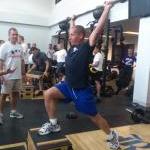Main Menu
Latest Blog Entry
User login
Sprint Training Mechanics: Frans Bosch
“Humans aren’t descended from apes, but are a bad crossbreed of kangaroos and horses”
 Frans Bosch delivered 4 great presentations at GAIN V this year each one packed full of information and ideas.
Frans Bosch delivered 4 great presentations at GAIN V this year each one packed full of information and ideas.
This included two practical sessions. One was gym- based and one was running -based. That helped immensely with my understanding and application.
Here are some of my thoughts on his analysis of sprint mechanics, based on his anatomical model. He looks not at how the “wheels turn, but how the motor runs”. This requires an internal focus of running mechanics, not an external focus.
He uses comparisons of human anatomy with that of kangaroos, horses and springboks: the best runners and jumpers. By comparing hamstring and gastrocnemius length with tendon length in the different species, we could see how improvements could be made in speed and jump training.
He started off with 3 building blocks for improving sprinting:
- Muscle slack (the most important)
- Reactivity
- Reflex Patterns
Working on improving and developing these areas will improve your running speed.
What is muscle slack?
Imagine a rope dangling from one end, then being pulled from both ends: the slack has been taken out of it. Jogging is bad running with more muscle slack, removing the slack increases your speed.
Slack is not a bad thing, it helps with control of lower speeds. But, to run fast you have to eliminate the slack.
The 2 ways to do this are either:
- Use a counter movement, which is what less coordinated and slower athletes do.
- Use pretension where the muscles are co-contracting (preferred option).

Reactive strength training
Bosch then explained why certain weight training exercises don’t help pretension because the bar does the work for the muscles. Instead, use other exercises that allow the body to provide solutions.
This video shows one of the exercises that Bosch showed us:
(As an aside someone from the ECB told me that a cricketer I was working with who couldn’t do a bodyweight squat, could be tested with a barbell because the weight helped him get lower to the ground! Unfortunately, he wasn’t allowed to do fielding in matches with that weight on his shoulders!).
Bosch has also eliminated the counter movement from any weight training exercises or drills that he is doing with the Welsh Rugby Union at present. This forces the rugby players to find another solution.
He has also reduced their reliance on ‘traditional’ weight training because the barbell reduces the muscle slack. This means that the players’ bodies don’t find a solution themselves.
4 Ways to get a bouncy athlete
- An erect posture (max 20 degrees of knee flexion when jumping). Really good jumpers have 5-9 degrees of knee amortization. These are sometimes known as speed jumpers compared to power jumpers. (Bosch said that power jumpers are just speed-jumpers with bad technique!)
- Short contact time and little change in joint angles
- Pretension prior to ground contact.
- Drop height no higher than the jump height of an athlete (you shouldn’t store more than you can unload)
Bosch then went into more detail on the running mechanics themselves (regular readers and our athletes will have as seen this before).
The pelvic girdle is very important in sprinting:
- The rotation forwards/ backwards
- The anterior/posterior tilting
- The elevation of the free hip
all influence how the hamstrings, abdominals and dorsal muscles are able to work effectively and maintain elastic energy in the running cycle.
Plantar flexion of the ankle and the timing of the foot contact are also essential components of sprint training. By ‘whipping’ the foot down the heel is encouraged to come off earlier.
Summary
I have barely scratched the surface of what was covered in these 4 seminars. I can’t say I grasped all of his concepts at this conference, but am able to watch the lectures back on video which helps!
I first saw Frans at the RFU speed conference 7 years ago and was blown away by the concepts. This is what we have been working towards with our athletes since then.
The bottom line is that our athletes are benefiting from this. (Jazmin Sawyers got a Long Jump bronze medal at the Junior World Championships having been trained using this methodology.)
- Luckily Gary Winckler developed the Bosch speed training principles at a later GAIN: How to develop speed
- This has helped me with the Speed Training I do at our Athletics Club in Devon.
Client Testimonials
 Middlesex LTA
Middlesex LTA
James has been training the top performance players in the county and has proved a great success. The sessions are well organised and the feedback and the programmes given to the players are excellent.
More


Comments
[…] Sprint training mechanics for rugby players […]
[…] athletes running fast and exploring different ways of moving. Using principles I have learnt from Frans Bosch and Gary Winckler I concentrate on 2 key points in any session at the most and then find 2-3 […]
[…] here for more on speed training drills and here for sprinting […]
Hi,
Do you have a copy of videos, you can share?
Many thanks,
Andre
Hi, lots of videos in my ebook Run Faster.